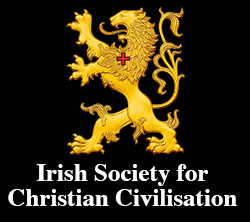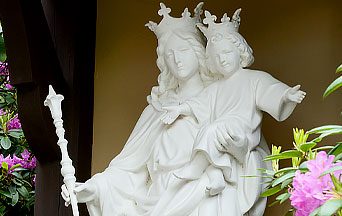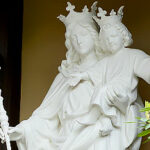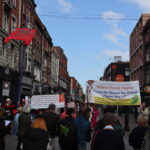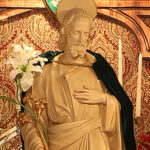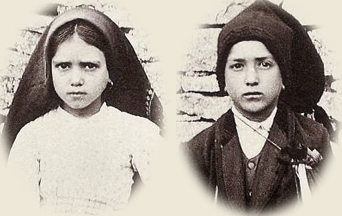
Francisco and Jacinta Marto are the youngest non-martyred children ever to be beatified. They were raised to the honour of the altars not simply because they saw Our Lady but also because they generously heeded her call to prayer, penance, and reparation. They are, thus, the first fruits of the Message of Fatima. This is the lesson that all of us, both young and old, should learn from the beatification of the two seers.
“With our Apostolic authority, we grant that, from this day forth, the venerable Servants of God Francisco Marto and Jacinta Marto be called ‘Blessed’ and that their feast day be celebrated yearly on February 20 in the places and according to the norms established by law.” This solemn Papal proclamation occasioned an explosion of joy in the square at Fatima on the morning of May 13, 2000.
On the last bench behind the altar in the Basilica of Fatima sat a 93-year-old Carmelite nun, Sister Lucia of the Immaculate Heart. She, in recollection, followed the solemn proceedings that raised her cousins Jacinta and Francisco to the honours of the altar, those same cousins with whom she had been privileged to see the “Lady more brilliant than the sun.” *
The Youngest Non-Martyred Children Ever to Be Beatified
Jacinta and Francisco Marto are the two youngest non-martyrs to be declared blessed in the history of the Church.

It is true that they received the enormous grace of the apparitions of the Most Blessed Virgin in Fatima. Nevertheless, they were not beatified simply for having seen and heard Our Lady. Rather, they were declared blessed because they attained sanctity. This they did by taking the apparitions seriously, drawing consequences from them for their personal lives and making of them the center of their thoughts and interests. They attained sanctity because they corresponded to the graces they received, generously heeding the Lady’s requests for prayer, penance, and reparation. It is their correspondence to these graces and their heeding of these requests that are now acknowledged in their beatification.
Francisco—An Innocent and Upright Soul, a Mild Temperament
Francisco and Jacinta Marto were, respectively, the eighth and ninth children of Manuel Pedro Marto, known as “Ti” Marto (Uncle Marto) and his wife, Olimpia de Jesus. Both were born in the hamlet of Aljustrel, in the parish of Fatima, Francisco on June 11, 1908, and Jacinta on March 11, 1910.
Ti Marto, the most respected person in the area in the opinion of his contemporaries, said that his youngest son enjoyed good health, had good nerves, was robust and resolute. “He was anything but a coward. He would go out at night, alone in the dark, without a sign of fear. He played with lizards and snakes and would roll them around a stick and make them drink out of holes in the rocks. Fearlessly he hunted hares and foxes and moles.”1
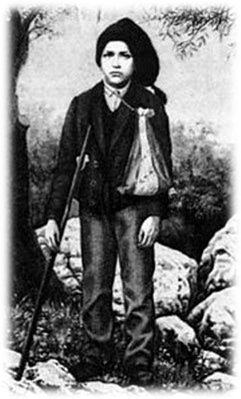
Francisco was docile and a model of obedience. Always kind and pleasant, “he would play with all the children without showing preference,” says Lucia, “and he never quarreled. But if something happened that he did not like, he would sometimes leave the game. If asked why he left, he would reply, ‘Because you’re bad,’ or simply, ‘Because I want to.’
“Although he tried his best at games,” continues Lucia, “he was dull to play with because he almost always lost. His peaceful temperament sometimes used to get very much on my nerves. If I ordered him to sit on a stone, he would meekly do so, as if I had to be obeyed. Later I would be sorry for my impatience and go to him, and he would always be as friendly as if nothing had happened.”2
Yes, Francisco liked games and play but he avoided confrontations. He surrendered his rights without a fight: “You think you won? That’s all right! I don’t mind!”3 “If one of the other children insisted on taking away something belonging to him,” says Lucia, “he said: ‘Let them have it! What do I care?’”4
He was very innocent and had a delicate conscience. One morning his mother suggested that he take advantage of his Godmother’s absence to take the sheep to pasture on her fields. He answered that he would not do that. When his mother slapped him across the face, he faced her with dignity and asked: “Is my mother teaching me to steal?” He went only after obtaining permission from his Godmother.
Francisco had an artist’s soul. He marveled at the beauties of creation. He loved the starry sky, the creeks and springs, and, above all, the sun, which he saw as the symbol of God’s power. Being a contemplative, he found entertainment in small things. With only his small flute he would spend hours on end content with playing nostalgic tunes reminiscent of heaven, or happy tunes for Lucia and Jacinta to dance to in the fields.
Like every child, Francisco had his small faults. Can it be that it was because of these that Our Lady said he would have to say many rosaries before he could go to heaven? For example, some nights he did not want to pray and would hide in the garden shed. His father had to go after him and bring him in. But, Ti Marto said that this was before the apparitions of Cova da Iria: “After Our Lady appeared, he was never missing; Francisco and Jacinta were the ones who insisted with everyone to say the rosary.”
In a few words, this was Francisco before the apparitions: innocent, preserved, a very upright soul, but perhaps a bit soft and carefree. Yet, this did not prevent the Mother of God from choosing him as one of her confidantes.
Jacinta—A Sensitive Temperament and an Upright Spirit
Lucia describes Jacinta as the opposite of Francisco, to the point that they did not seem like brother and sister except for their similar features.
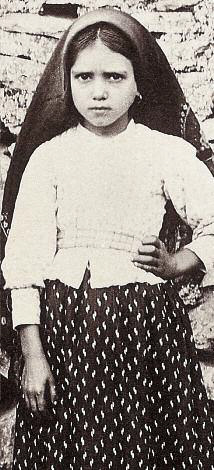
Her soul was extraordinarily sensitive and very easily impressed. “When she was five years old or less,” relates Lucia, “she would melt into tears on hearing the story of the Passion of Our Lord. ‘Poor Jesus,’ she would say, ‘I must never sin and offend Him any more.’” She ran as if from the plague from those who spoke bad words or held questionable conversations “because this is a sin and saddens Our Lord.”5
She also shunned lying, understanding its sinfulness. Her father relates: “When her mother told her some little fib, such as that she was only going to the cabbage-patch when she was really going much farther, Jacinta would always detect the deception and not hesitate to scold her own mother: ‘So, mother is lying to me? She said she was going here and went there? Lying is ugly!’”6
Like her brother Francisco, and perhaps more than he, hers was a refined, tender, and affectionate soul.
She loved her sheep and gave each of them a name—Dove, Star, Meek, Snow, and the like. The white baby lambs were her favorite. Many times she carried them over her shoulders as she had seen Our Lord depicted carrying them on holy cards.
Jacinta had a veritable passion for flowers. Gathering them in the fields was one of her favorite pastimes. Sometimes she made garlands with them to adorn her cousin. At other times, she would take them apart to toss their petals at Lucia as she had seen the little girls dressed as angels doing in the Corpus Christi procession.
She loved the moon, which she called “Our Lady’s lamp.” She preferred it to the sun, “because it does not hurt the eyes.” When the moon was full, she would run to break the good news: “Mother, here comes the queen of the sky!”
Had this little angel no defects? Yes, she had them, albeit small ones. Lucia tells us that Jacinta was a little spoiled, being the baby of a large family. Because of this, when things did not go her way, she sulked a bit. Then, the only way to get her to return to the games was to allow her to choose not only the next game but also her partner. With her amazing energy, she would sometimes go a bit overboard in dancing, which is quite a common pastime among the Portuguese peasantry. With incredible agility and grace she skipped and hopped until flushed and breathless.
On this point her biographer, Fr. Joseph Galamba de Oliveira, comments: “The faults and imperfections we note in her life are evident proof of the transformation later effected in her soul by grace and the generosity with which she responded to the workings of the Holy Spirit.”7
These souls, with much that was angelic, were thus prepared by divine grace to receive the heavenly visits.
Apparitions Propel These Childish Souls Toward Sanctity
In the spring of 1916 the life of the three happy and carefree little shepherds of only nine, eight, and seven years was to suffer a dramatic change after an angel appeared and spoke to them. “The Hearts of Jesus and Mary are attentive to the voice of your supplications.”8
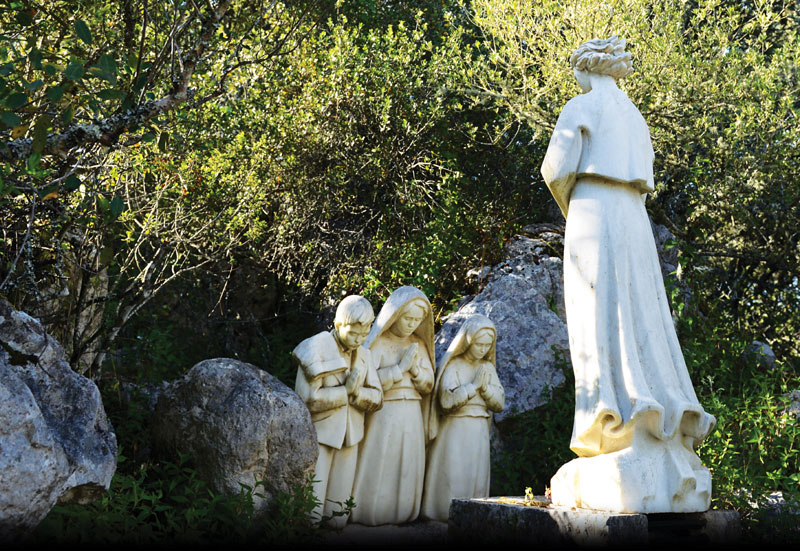
In another apparition in the summer of that same year, the angel advised: “Offer prayers and sacrifices constantly to the Most High…. Make of everything you can a sacrifice, and offer it to God as an act of reparation for the sins by which He is offended, and in supplication for the conversion of sinners…. Above all, accept and bear with submission the suffering the Lord will send you.”9
This is a regime of sanctity that is asked only of those who are called to be truly intimate with Our Lord. The three fulfilled it to the letter with fervor, without complaining or self-pity, with true joy and loving submission. They even went so far as to invent various ways of sacrificing themselves.
Thus, around a year later, they were ready to receive the visit of the Queen of Heaven.
When she came, it was not with pleasantries or caresses but with seriousness. In the very first encounter she repeated the angel’s invitation to prayer and suffering: “You will have much to suffer, but the grace of God will be your comfort.”10
They were asked to offer up prayer and suffering in reparation to the Sacred Heart of Jesus and the Immaculate Heart of Mary, so offended by the terrible apostasy of humanity. They were to understand the full extent of this request only as time went by and with the help of a special grace.
Francisco—A Contemplative Soul, a “Consoler of God”
Though innocent and detached, Francisco must still have had some weaknesses or small lack of generosity that he needed to correct. If these did not keep him from seeing the angel and Our Lady, nevertheless, he could not hear them.
Still, when his cousin told him that the Lady had said he must say “many rosaries” so that she could also take him to heaven, he exclaimed without a shadow of resentment or envy, “O, my dear Our Lady! I will say as many rosaries as you want!”11
Curiously, of the three, Francisco was the least impressed with the vision of Hell. During that vision, what most attracted and absorbed him was God, the Holy Trinity “in that immense light that penetrated us to our innermost souls.” This gives us an idea of this small shepherd’s spirituality and of the vocation God gave him.
In any case, the vision of Hell marked a decisive threshold in the spiritual lives of all three seers. It was after the vision that the little shepherds began to make great spiritual progress.
Lucia comments, “While Jacinta seemed to think only of converting sinners and of saving souls from going to Hell, Francisco seemed to think only of consoling Our Lord and Our Lady, who had seemed so sad.” When his cousin asked him what he liked best, to console Our Lord or to convert sinners, he did not hesitate: “I’d rather console Our Lord. Don’t you remember how sad Our Lady was the last month when she said not to offend Our Lord, because He was much offended already? I want to console Our Lord first and then convert the sinners so that they won’t offend anymore.”12
With reason, Fr. Jose Maria Alonso comments: “A consoling reparation as expressed by the words of Francisco, of a type that is so exquisitely ‘theocentric’ is not possible without an extraordinary mystical grace.”13

Following this appeal for contemplation, Francisco, wanting to pray alone, frequently took leave of the girls. When they asked him what he was doing, he showed them his rosary. If they insisted with him to come play with them he answered, “Don’t you remember that Our Lady said that I must pray many rosaries?”14 And if they asked why he did not pray with them he answered, “I’d rather pray alone, to think, and to console Our Lord. He is so sad.”15
When the little shepherds began going to school, Francisco said to the two girls, “Look, you go to school and I will stay here in the church near the hidden Jesus. It isn’t worth the trouble for me to learn to read. I am leaving here soon for heaven. When you come back, call me.”16 Thus, he spent hours before the Blessed Sacrament, seeking to console and gladden his God.
Sometimes the girls found him absorbed in thought behind a small wall. Asking him what he was doing, he answered, “I’ve been thinking of God. I’ve been thinking of Our Lord and of all the sins that have made Him unhappy. O, Lucia, if only I could comfort Him.”17
To comfort God, to gladden Him, what a high ideal! What a program for life! This is to practice the first commandment in a sublime manner, forgetting oneself and loving God above all things.
Thus, led by the Holy Ghost, Francisco took great strides along the contemplative way.
“It is likely enough,” comments William Thomas Walsh, “that in this way, without direction, Francisco learned to practice mental prayer. He may well have become a fairly advanced contemplative, he may possibly have had ecstasies. He had learned from the Master Himself the lesson that Saint Teresa teaches in her The Way of Perfection: that lofty prayer demands love, solitude, detachment, freedom from all self-seeking or sensuality.”18
Small in Age but Great in the Spirit of Sacrifice
The three little shepherds found a thousand ways of mortifying themselves: giving their lunch to the poor; eating bitter roots; going without water a whole day and suffering greatly from thirst; rubbing their bodies with nettles; remaining prostrate on their faces for hours while reciting the prayers the angel had taught them and other prayers that their fervor inspired.
One day they found a rough piece of rope and immediately tied it around their waists under their clothes. This was so uncomfortable that they often could not sleep. Our Lady herself had to tell them not to use this instrument of penance at night.
A priest once also recommended that they pray for the Holy Father, explaining to them who he was. After this, they added three Hail Marys at the end of their rosaries for the intentions of the common Father of Christendom.
Francisco—Heroic Patience in Suffering
On December 23, 1918, brother and sister fell victims to the epidemic of bronchial pneumonia that was ravishing Europe. Even in sickness they continued to sacrifice themselves for sinners.
Lucia writes about Francisco:
“He suffered with heroic patience, never letting a single complaint or moan escape. He drank everything his mother gave him and I could never tell if anything repulsed him.
“I asked him one day a little before he died, ‘Francisco, do you suffer much?’
“‘Yes, I suffer. But I suffer everything for the love of Our Lord and Our Lady.’
“One day he gave me the rope (the one he used around his waist as a penance) and said: ‘Take it before my mother sees it. I’m not able to use it anymore around my waist.’
“This rope had three knots in it and was blood stained.”
On April 4, 1919, without a single moan or facial contraction, quietly, and with an angelic smile on his lips, Francisco went forth to meet the Most Blessed Virgin who awaited him with open arms.
Jacinta—Reparatory Victim, Serious and Generous
After the apparitions, Jacinta took her mission to pray for sinners so seriously that she was favored with several mystical graces. She had prophetic visions and obtained cures and graces that were considered miraculous, and she is even said to have had an instance of bilocation.
Still in Fatima, in the year following the apparitions, Our Lady appeared to her three more times.
The maturity and precocity of this humble little shepherdess was impressive. Lucia witnesses:
“She had a serious, modest and kind demeanor that seemed to let the presence of God shine through in all her actions; a demeanor usually seen in much older persons who are far advanced in virtue.
“If in her presence, a child or even adult persons said or did something that was improper, she would reprimand them: ‘Do not do this because you offend Our Lord, and He is already much offended.’”
Lucia says, “Our good God gave me the grace of being her intimate confidante; I miss her greatly, and remember her with love and respect in appreciation for her sanctity.” In another place Lucia says she owes the preservation of her innocence partly to the company of Jacinta.19
Her painful illness was an occasion for her to offer many sacrifices to God. One day she asked Lucia: “Have you made any sacrifices today? I have made many. My mother went away and I wanted to see Francisco many times, but I did not go.”20
Another day she said: “It is becoming harder and harder for me to drink milk and broth, but I do not say anything. I take them all for the love of Our Lord and of the Immaculate Heart of Mary, our dear Heavenly Mother.”21
Reparatory Victim of the Immaculate Heart of Mary
Jacinta’s reparatory mission is intimately linked to the Immaculate Heart of Mary. When Our Lady showed Hell to the three little shepherds, she said: “You saw Hell where the souls of poor sinners go; to save them, God wishes to establish in the world the devotion to my Immaculate Heart.” Jacinta was, in her own way, a missionary of this devotion.
Thus, “Jacinta well deserves the title of model-reparatory-victim of the Immaculate Heart of Mary. For us who wish to live in depth the Message of Fatima, this is how we should see it.”22
One day she confided to Lucia that, when alone, she got down from the bed many times to say the prayer of the angel: “But now, I can no longer touch my head to the floor because I fall down, and so I kneel and pray.”23
How could so young a child as Jacinta understand so deeply and take on so seriously the spirit of mortification and penance?
Lucia answers: “First, by means of a special grace that God wished to grant her through the Immaculate Heart of Mary. Secondly, after having seen Hell and the unhappiness of souls who fall there.”
Father Alonso comments: “Before Jacinta, Lucia herself felt what is usually felt before a holy person who seems to be in communion with God in everything…. The sight of Hell had horrified her so much that all the penances and mortifications seemed as nothing so long as she could save a few souls from going there.”24
Our Lady had asked Jacinta if she wanted to remain on earth for a little longer to continue suffering for the conversion of sinners. The generous child had said yes. With this, she went to two hospitals where she suffered much and finally died alone in Lisbon far from her family. But Our Lady did not abandon her. She appeared to her frequently, instructing her, counseling her, showing her the situation of the world and the imminence of chastisements.
Mother Maria of the Purification Godinho, in whom Jacinta confided, wrote down many of the heavenly communications and meditations of the little, young shepherdess which were later published in several books. In these, the spiritual maturity attained by this girl of barely ten years can be appreciated.A Profound and Serious Understanding of Eternity
Seeing people who visited the sick immodestly dressed or nurses who wore too much makeup, she would say to Mother Godinho: “What good is all this? If they only considered that they will have to die one day and knew what eternity is!” About some atheistic doctors, she commented: “Poor men! With all their science they hardly know what awaits them.” After Mother Godinho asked her to pray for certain hardened sinners, she answered: “Yes, my Mother; but for these there is no more remedy!”
Jacinta underwent a second operation in February of 1920. Because of her weakened condition the doctors could only use chloroform and local anesthesia. Finding herself without clothing in the doctors’ hands, she cried. Two ribs were extracted, leaving a cavity large enough for a hand to be introduced. She bore it all quietly, only whispering painfully at times: “O, my Our Lady!” But, to console those who saw her suffering, she would say, “Patience! We all must suffer to go to Heaven.”
“Our Lord united Jacinta most intimately to His dolorous passion and the sufferings of the Blessed Virgin. Yet, all the consolation she derived from the visits of Our Lady did not prevent her own passion from reaching the limits of a most intense martyrdom. We could say that to be a model of a reparatory victim, Jacinta had to experience all the nights of the senses and the spirit, suffering the fearsome solitude that she so dreaded.”25
On Friday, February 20, Our Lady came to take Jacinta.
“When Mother Godinho held vigil beside the coffin, she glanced at the little lamp nearby. She was astonished to see that the lamp contained no oil but still burned brightly. Her body which at times before death did not exude a pleasant odor, because of infection and open sores, and the extreme sufferings which afflicted her, after death exuded the scent of sweet perfume. When the body was carried into the Lisbon Church, the bells rang while no one was at the ropes, and the tower door was locked.”26
Jacinta’s body was first exhumed on September 12, 1935. Her incorrupt face appeared much older than she was at the time of her death. “Perhaps one explanation is that her body reflected her spiritual maturity at the time of her death, which came when Jacinta was not quite ten years old.”27
“Unless You Become as Little Children…”
These two children died, respectively, before their eleventh and tenth years, yet each practiced the three theological virtues and the four cardinal virtues in the degree required to be raised to the honors of the altar, that is, heroically.
The beatification of Jacinta and Francisco should serve as a lesson for our children who have in these little shepherds of Fatima apt models for their age.
Should they be models only for children? By no means. They can and should also serve as models for adults who find in their own weaknesses and shortcomings an excuse to avoid the ways to sanctity. Here we can fittingly apply our Divine Savior’s admonition: “Unless you become as little children, you shall not enter the Kingdom of Heaven” (Matt. 23:3). We must follow the example of Francisco and Jacinta and heed with open hearts Our Lady’s requests at Fatima, her emphatic requests for prayer, penance, and reparation.
“I praise Thee, O Father, Lord of Heaven and earth, because thou hast hidden these things from the wise and prudent and hast revealed them to little ones” (Luke 10:21).
This article was originally published in the July/August 2000 edition of Crusade Magazine.
* — Quotations without references in the text are taken from Sister Lucia’s manuscript.
Footnotes:
1. Rev. John de Marchi, I.M.C., The True Story of Fatima (St. Paul, Minn, 1952), p. 28. 2. Ibid., pp. 27-28. 3. Rev. Fernando Leite, S.J., Francisco of Fatima (Fatima, 1992), p. 10. 4. Ibid., p. 12. 5. De Marchi, p. 32. 6. Ibid., p. 31. 7. Rev. Joseph Galamba de Oliveira, Jacinta, the Flower of Fatima, (New York, 1946), p. 50. 8. Leite, p. 26. 9. Ibid., p. 28. 10. Ibid., p. 34. 11. Leite, p. 58. 12. William T. Walsh, Our Lady of Fatima (New York, 1949), p. 162. 13. Fr. Joaquim Maria Alonso, Doctrina y espiritualidad del mesaje de Fatima (Madrid, 1990), p. 127. 14. Leite, p. 58. 15. Walsh, p. 162. 16. Ibid., p. 161. 17. De Marchi, p. 238. 18. Walsh, pp. 161-162. 19. Galamba de Oliveira, p. 54. 20. Ibid., p. 166. 21. Ibid., p. 165. 22. Alonso, p. 143. 23. Galamba de Oliveira, p. 166. 24. Alonso, pp. 132-134. 25. Ibid., p. 144. 26. Fr. Robert Fox, “The Faith of the Fatima Shepherds: Spirituality of Blessed Jacinta Marto,” part 2, Daily Catholic 2000, May 8, 2000. 27. Ibid.
This year, it is more crucial than ever that we turn to prayer and intercession to increase devotion to Our Lady across our country. That’s why you’re invited to join us in the Three Hail Marys Pledge, a powerful devotion that can bring personal spiritual benefits and national transformation. By reciting three Hail Marys daily, you honour the Immaculate Heart of Mary and seek her intercession for the conversion of sinners, the salvation of souls and the restoration of Ireland’s Catholic Faith. This ancient devotion, revealed to Saint Mechtilde, promises spiritual benefits including protection from mortal sin and the assurance of a good death. Your daily prayers will contribute to an increase in devotion to Our Lady, the conversion of sinners and the moral renewal of our country. Let us commit to this powerful devotion and seek the guidance and protection of Our Lady.


